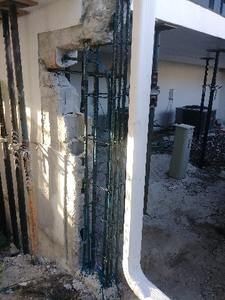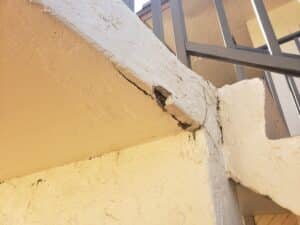Concrete and stucco are widely used building materials in Condo-HOA and commercial properties due to their durability and aesthetic appeal. However, exposure to harsh weather conditions, water infiltration, and general wear and tear can cause these surfaces to deteriorate over time. To maintain the structural integrity and appearance of your buildings, it’s crucial to address concrete and stucco issues with professional restoration services.
This ultimate guide to concrete and stucco restoration for Condo-HOAs and commercial properties will provide property managers and board members with detailed information, including the following topics:
- Identifying concrete and stucco issues: Learn how to spot common signs of damage and deterioration, such as cracks, chipping, efflorescence, and discoloration, that warrant immediate attention and restoration efforts.
- Surface preparation and repair techniques: Discover best practices for preparing concrete and stucco surfaces for restoration, including methods for removing old coatings, cleaning, and repairing damaged areas.
- Choice of materials and application techniques: Understand the importance of selecting high-quality materials and using proper application techniques for effective and long-lasting restoration results.
- Preventive maintenance and future protection: Learn valuable tips for routine inspection, maintenance procedures, and protective measures to prevent future damage and increase the life span of your concrete and stucco surfaces.
This guide will offer a varied mix of article types, including listicles, expert advice, FAQs, comparisons, myths vs. facts, glossaries, and more, ensuring a comprehensive and engaging exploration of concrete and stucco restoration. Our objective is to assist you in making well-informed decisions on the maintenance and restoration of your Condo-HOA or commercial property.
As certified and insured Florida General Contractors, McLeod’s Contracting Solutions has extensive experience in concrete and stucco restoration for Condo-HOAs and commercial properties. Contact us today for a free quote on our professional services and let our team of experts help you maintain the visual appeal and safety of your property investment.
Identifying Concrete and Stucco Issues
To create a solid foundation for your restoration project, it’s crucial to identify concrete and stucco damage on your property. Common signs of deterioration include:
- Cracks: Surface cracks, whether hairline or more significant, can indicate structural issues or simply result from natural expansions and contractions. Cracks can lead to water damage, so addressing these issues early on is essential.
- Chipping: Loose or chipped stucco is often the result of water infiltration, impacts, or improper installation. These areas need to be repaired to maintain building aesthetics and prevent further damage.
- Efflorescence: This white, powdery substance is caused by soluble salts in the concrete or stucco being drawn to the surface. Efflorescence indicates water infiltration, which can lead to more severe issues if left untreated.
- Discoloration: Stains or discoloration on your concrete or stucco surfaces can result from water infiltration or exposure to harsh weather elements. Determining the cause and addressing the problem is vital for maintaining the appearance and structural integrity of your building.
Surface Preparation and Repair Techniques
Proper surface preparation is critical for successful concrete and stucco restoration. Here are some techniques for preparing your surfaces:
- Removing Old Coatings: Old coatings and paint should be removed before beginning restoration to ensure proper repair material adhesion. Sandblasting, power washing, or using chemical paint removers are common methods for removing old coatings.
- Cleaning: Dirt and debris should be removed from the surface before any repairs are made to ensure good adhesion of repair materials. Gentle pressure washing and cleaning agents can help achieve a clean surface.
- Repairing Damaged Areas: Depending on the extent of the damage, different repair techniques may be needed. For small cracks and chips, patching compounds may suffice, while more extensive damage might require replacement of entire sections of concrete or stucco.
- Sealing and Waterproofing: After repairing any damage, applying waterproofing materials or sealants can help protect the surface from future damage and increase its lifespan.
Choice of Materials and Application Techniques
The materials used for your concrete and stucco restoration project are just as important as surface preparation and repair techniques. Consider the following when choosing materials and application methods:
- Material Compatibility: Make sure the repair material is compatible with the existing concrete or stucco surface. Compatibility ensures proper adhesion and prevents further issues down the line.
- Durability: Look for high-quality materials with excellent durability and weather resistance. Investing in superior materials ensures a long-lasting restoration.
- Application Techniques: Choose materials that can be applied using standard techniques, such as troweling or spraying. This ensures a smooth and uniform surface appearance.
- Aesthetic Appeal: Consider the visual appeal of the materials used in your restoration project. Select materials and colors that match or complement the existing structure to maintain its aesthetic appearance.
Preventive Maintenance and Future Protection
Maintaining and protecting your concrete and stucco surfaces will help you avoid ongoing issues and ensure long-lasting restoration results. Here are some tips for preventive maintenance and future protection:
- Routine Inspections: Regularly inspect your concrete and stucco surfaces for signs of damage, like cracks, chipping, or efflorescence. Early detection of issues allows for prompt repairs.
- Cleaning and Maintenance: Keeping your surfaces clean and free of debris helps prevent the buildup of dirt and contaminants that could contribute to damage. Utilize gentle cleaning methods to avoid causing damage during the cleaning process.
- Proper Drainage: Make sure your property has adequate drainage systems to prevent water accumulation and infiltration, which can lead to concrete and stucco damage.
- Protective Coatings: Applying protective coatings, such as sealants or water repellents, can provide an extra layer of protection against water infiltration, chemical exposure, and other potential sources of damage.
Conclusion
Concrete and stucco restoration is a vital aspect of maintaining the structural integrity and aesthetic appeal of your Condo-HOA or commercial property. By identifying issues early, preparing and repairing surfaces properly, and utilizing high-quality materials and application techniques, you can ensure a successful and long-lasting restoration project. Additionally, implementing preventive maintenance and protective measures will help minimize future damage and prolong the life span of your concrete and stucco surfaces.
Looking to restore your concrete or stucco surfaces for your Condo-HOAs or commercial properties? Look no further than McLeod’s Contracting Solutions! Our certified and insured team of experts specialize in providing professional guidance and expert restoration services to ensure your project is handled with the utmost care and precision. Contact us today for a free quote and let us help you transform your property into something truly spectacular!







